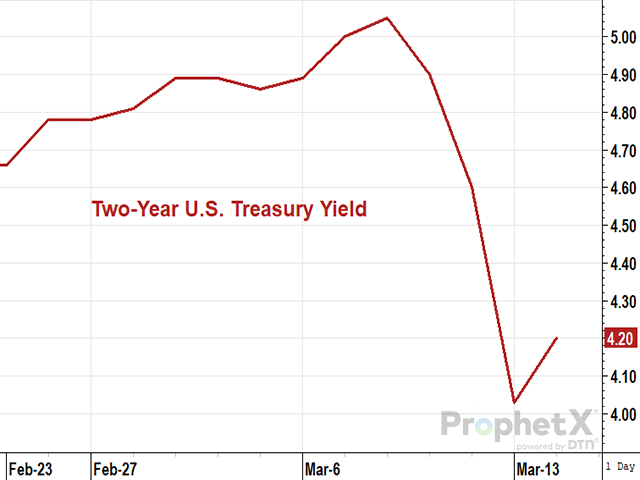An Urban's Rural View
The Federal Reserve's Agonizing Dilemma
A not-very-funny thing happened to the Federal Reserve on its way to rescuing the banking system: Its campaign to rein in inflation was undermined. That raises questions about where interest rates are headed and leaves the Fed in an agonizing dilemma. Can it both fight inflation and save the financial system?
The bond market knows the short-term answer. In reaction to the failure of Silicon Valley Bank, bonds staged their biggest rally since 1987 as investors scrambled to board the lifeboats. Bond prices and yields move inversely, and with the rally the yield on the two-year Treasury note plunged a full percentage point, from just above 5% to just above 4%.
This leaves the central bank and the markets at odds. The Fed is committed to raising interest rates. The bond market is now lowering rates -- and expecting the Fed to at least lighten up.
Last week Federal-funds futures indicated investors were betting there was a nearly 80% chance the Fed would raise interest rates a full half percentage point at its meeting on March 21 and 22. After the rally, the bet was on a 66% chance of a quarter point increase and a 34% chance of no increase at all. (https://www.wsj.com/…)
In its campaign to bring inflation back down to its 2% target, the Fed has expressed a willingness to let higher rates inflict a recession on the economy. The failure of Silicon Valley Bank is a reminder that rising rates can also imperil the financial system. The Fed is a lot less willing for that to happen.
P[L1] D[0x0] M[300x250] OOP[F] ADUNIT[] T[]
During the tech boomlet COVID-19 touched off, Silicon Valley Bank couldn't lend to companies as fast as deposits gushed in. It bought U.S. Treasuries instead.
But rising interest rates reduced the market value of those Treasuries and as the tech boomlet unwound depositors were withdrawing money. Although SVB had intended to hold the Treasuries to maturity, it was forced to sell some at a loss to fund the withdrawals. As its financial condition weakened, its stock price fell sharply. Depositors naturally wanted to head for the hills.
If the Fed hadn't stepped in to protect depositors from losses, many technology startup companies would have gone under. These Silicon Valley citizens understandably command little public sympathy. They're a privileged lot who many see as hypocrites, boasting of being risk takers one day, begging help from the government the next. Why should they get a bailout?
They got one because the Fed and the Treasury feared the fire would spread, putting the financial system at risk. Higher interest rates are squeezing other regional banks with less pampered depositors, though not to the same extent. By stepping in, the government hopefully headed off cascading bank runs.
That doesn't mean there aren't lots of tough questions to be answered. Why didn't regulators catch the problem earlier? Are all deposits at every bank now effectively federally insured, not just the first $250,000? If so, won't banks be encouraged to take even more risks that imperil financial stability? If banking discipline is to be maintained, won't more regulation be inevitable?
You can bet a lot of angry words will be exchanged in Congress as those questions come up for debate. You are sure to hear attacks on bailouts for elites during the next round of political campaigns.
What does all this mean for farmers and ranchers? DTN Lead Analyst Todd Hultman has written insightfully about the possible hit to ag futures prices seeing that "...corn, soybeans and cattle have large net-long positions held by specs and look vulnerable to increased anxiety over the bank failures and the possibility there may be more ahead." (https://www.dtnpf.com/…) DTN Political Correspondent Jerry Hagstrom and DTN Ag Policy Editor Chris Clayton have pointed out that Silicon Valley Bank backed a number of high-tech food startups, including Beyond Meat. (https://www.dtnpf.com/…)
The other thing for farmers and ranchers and other business borrowers to watch is interest rates. In past financial crises the Fed has cut them. It could do so again this time if today's higher rates squeeze still more banks.
At the very least, bond investors are probably right in thinking the SVB failure will discourage a big Fed rate increase March 21-22. The question is what happens later, as the financial waters calm.
What will the Fed do if stubborn inflation can only be controlled by further rate increases, but those increases threaten the survival of other good-sized banks? As investors wait to see how the Fed resolves this dilemma, brace yourselves for market volatility.
Urban Lehner can be reached at urbanize@gmail.com
(c) Copyright 2023 DTN, LLC. All rights reserved.




